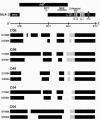Longitudinal analysis of human immunodeficiency virus type 1 nef/long terminal repeat sequences in a cohort of long-term survivors infected from a single source
- PMID: 16379007
- PMCID: PMC1346882
- DOI: 10.1128/JVI.80.2.1047-1052.2006
Longitudinal analysis of human immunodeficiency virus type 1 nef/long terminal repeat sequences in a cohort of long-term survivors infected from a single source
Abstract
We studied the evolution of human immunodeficiency virus type 1 (HIV-1) in a cohort of long-term survivors infected with an attenuated strain of HIV-1 acquired from a single source. Although the cohort members experienced differing clinical courses, we demonstrate similar evolution of HIV-1 nef/long-terminal repeat (LTR) sequences, characterized by progressive sequence deletions tending toward a minimal nef/LTR structure that retains only sequence elements required for viral replication. The in vivo pathogenicity of attenuated HIV-1 is therefore dictated by viral and/or host factors other than those that impose a unidirectional selection pressure on the nef/LTR region of the HIV-1 genome.
Figures



Similar articles
-
Persistence of attenuated HIV-1 rev alleles in an epidemiologically linked cohort of long-term survivors infected with nef-deleted virus.Retrovirology. 2007 Jul 1;4:43. doi: 10.1186/1742-4690-4-43. Retrovirology. 2007. PMID: 17601342 Free PMC article.
-
Viral phenotypes and antibody responses in long-term survivors infected with attenuated human immunodeficiency virus type 1 containing deletions in the nef and long terminal repeat regions.J Virol. 2007 Sep;81(17):9268-78. doi: 10.1128/JVI.00650-07. Epub 2007 Jun 13. J Virol. 2007. PMID: 17567690 Free PMC article.
-
Longitudinal analysis of nef/long terminal repeat-deleted HIV-1 in blood and cerebrospinal fluid of a long-term survivor who developed HIV-associated dementia.J Infect Dis. 2004 Dec 15;190(12):2181-6. doi: 10.1086/425585. Epub 2004 Nov 16. J Infect Dis. 2004. PMID: 15551218
-
The Sydney Blood Bank Cohort: implications for viral fitness as a cause of elite control.Curr Opin HIV AIDS. 2011 May;6(3):151-6. doi: 10.1097/COH.0b013e3283454d5b. Curr Opin HIV AIDS. 2011. PMID: 21378562 Review.
-
The tat gene and protein of the human immunodeficiency virus type 1.New Microbiol. 1995 Jan;18(1):87-110. New Microbiol. 1995. PMID: 7760763 Review. No abstract available.
Cited by
-
Modulation of HIV pathogenesis and T-cell signaling by HIV-1 Nef.Future Virol. 2012 Jun 1;7(6):609-620. doi: 10.2217/FVL.12.42. Future Virol. 2012. PMID: 22844345 Free PMC article.
-
The remarkable frequency of human immunodeficiency virus type 1 genetic recombination.Microbiol Mol Biol Rev. 2009 Sep;73(3):451-80, Table of Contents. doi: 10.1128/MMBR.00012-09. Microbiol Mol Biol Rev. 2009. PMID: 19721086 Free PMC article. Review.
-
Transcriptional activity of blood-and cerebrospinal fluid-derived nef/long-terminal repeat sequences isolated from a slow progressor infected with nef-deleted human immunodeficiency virus type 1 (HIV-1) who developed HIV-associated dementia.J Neurovirol. 2006 Jun;12(3):219-28. doi: 10.1080/13550280600827369. J Neurovirol. 2006. PMID: 16877303
-
Possible clearance of transfusion-acquired nef/LTR-deleted attenuated HIV-1 infection by an elite controller with CCR5 Δ32 heterozygous and HLA-B57 genotype.J Virus Erad. 2019 Apr 1;5(2):73-83. doi: 10.1016/S2055-6640(20)30696-11. J Virus Erad. 2019. PMID: 31191910 Free PMC article.
-
Macrophage Tropism and Cytopathicity of HIV-1 Variants Isolated Sequentially from a Long-Term Survivor Infected with nef-Deleted Virus.Open Microbiol J. 2007;1:1-7. doi: 10.2174/1874285800701010001. Epub 2007 Jun 25. Open Microbiol J. 2007. PMID: 19088897 Free PMC article.
References
-
- Birch, M. R., J. C. Learmont, W. B. Dyer, N. J. Deacon, J. J. Zaunders, N. Saksena, A. L. Cunningham, J. Mills, and J. S. Sullivan. 2001. An examination of signs of disease progression in survivors of the Sydney Blood Bank Cohort (SBBC). J. Clin. Virol. 22:263-270. - PubMed
-
- Chakrabarti, L., V. Baptiste, E. Khatissian, M. C. Cumont, A. M. Aubertin, L. Montagnier, and B. Hurtrel. 1995. Limited viral spread and rapid immune response in lymph nodes of macaques inoculated with attenuated simian immunodeficiency virus. Virology 213:535-548. - PubMed
-
- Churchill, M., J. Sterjovski, L. Gray, D. Cowley, C. Chatfield, J. Learmont, J. S. Sullivan, S. M. Crowe, J. Mills, B. J. Brew, S. L. Wesselingh, D. A. McPhee, and P. R. Gorry. 2004. Longitudinal analysis of nef/long terminal repeat-deleted HIV-1 in blood and cerebrospinal fluid of a long-term survivor who developed HIV-associated dementia. J. Infect. Dis. 190:2181-2186. - PubMed
-
- Crowe, S. M., D. D. Ho, D. Marriott, B. Brew, P. R. Gorry, J. S. Sullivan, J. Learmont, and J. Mills. 2005. In vivo replication kinetics of a nef-deleted strain of HIV-1. AIDS 19:842-843. - PubMed
Publication types
MeSH terms
Substances
Associated data
- Actions
- Actions
- Actions
- Actions
- Actions
- Actions
- Actions
- Actions
- Actions
- Actions
- Actions
- Actions
- Actions
- Actions
- Actions
- Actions
- Actions
- Actions
- Actions
- Actions
- Actions
- Actions
- Actions
- Actions
- Actions
- Actions
- Actions
- Actions
- Actions
- Actions
- Actions
- Actions
- Actions
- Actions
- Actions
- Actions
- Actions
- Actions
- Actions
- Actions
Grants and funding
LinkOut - more resources
Full Text Sources
Medical

